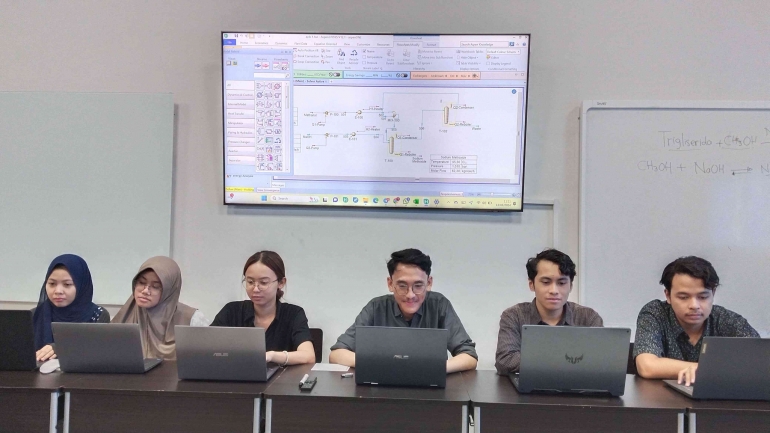The Industrial Chemical Engineering Technology Study Program (TRKI) at the Vocational School, Diponegoro University (Undip), has implemented the OB TVET concept (Principles, Infrastructure, and Superstructure), to welcome cybergogy learning. Learning actively links creativity through Web 4.0, communicating, collaborating in cyberspace, self-regulated, ownership, generative, inspiring, and meaningful humans to prepare graduates to perform according to the needs of the millennial industry.
Mohamad Endy Yulianto, the lecturer of the Chemical Industrial Process Analysis (APIK) course, said that APIK was taught together with lecturers from industrial practitioner Tjoek Oedowo, ST., MH., as Managing Director of PT Wealthindo Putrapramesti Perkasa, who has more than 25 years of experience as a senior manager at PT. South Pacific Viscose. The material presented includes case studies directly in industry, miniplants, and students directly replicating problem solvers based on simulators such as Aspen Plus, Aspen HYSYS, and Matlab.
Ade Kurnianto explained that the simulation of the development of the sodium methylate catalyst industry was motivated by the fossil fuel-based energy crisis, which had become a problem because its availability was very limited in addition to causing global warming. Various efforts have been made to find alternative fuels that are renewable and environmentally friendly, including the use of biodiesel biofuel. The increase in biodiesel production capacity worldwide has created a major market for the production of sodium methylate, or sodium methoxide, as a catalyst in the transesterification of vegetable oils.
Sodium methylate is a chemical reagent used for decades in various industries to produce high-value products such as medicines, foodstuffs, pigments, and plant protection agents. In recent years, biodiesel production has become attractive, renewable, and applications of sodium methylate catalysts are growing rapidly. However, the fulfillment of sodium methylate as a reliable catalyst for biodiesel production in Indonesia is still through imports, explained Mash’ulatul Eryl Fatdilla.
Axzhel Dinda Pratiwi revealed that increasing biodiesel production has an impact on increasing the need for catalysts that function to accelerate biodiesel synthesis. Common base catalysts include NaOH, KOH, and NaOCH3. However, the majority of the biodiesel industry currently uses 30% sodium methylate (NaOCH3) in methanol as a catalyst. This is because NaOCH3 can increase biodiesel yield, reduce the amount of raw material and speed up reaction time compared to other base catalysts.
The main advantage of the CH3ONa catalyst is that it is water-free, so the saponification process can be minimized. This leads to higher yields, lower refining costs, and consistent biodiesel quality. Even though it has a huge market opportunity, there is no industry that produces sodium methylate in Indonesia, because the process is considered to be less efficient. Biodiesel producers are currently still importing to meet their catalyst needs, said Daffandra Juniarko.
Reza Kautsar Insani added that commercial production of sodium methylate using raw materials such as: sodium amalgam, sodium metal, and sodium acetate based on sodium amalgam already exists in several countries. However, processes using this raw material have now been abandoned due to health and environmental concerns related to the use of mercury, which spread contamination to various ecosystems. The reactive stripping process is thought to have many advantages, including: cheaper raw materials, safer process risks, and higher conversion.
Although the energy consumption to separate methanol from water and maintain the methanol recycling stream is higher. However, this process is more competitive because, theoretically, it has the highest chance of profitability of around 41%. Therefore, the success of this innovative reactive sipping process still depends on the rate of the methoxylation reaction to form sodium methylate and separate water from the product. “For this reason, it is necessary to simulate using ASPEN HYSYS, considering that the presence of water in methanol will affect the back reaction of methoxylation,” concluded Shafira Ardaneshwari Santoso.


Recent Comments